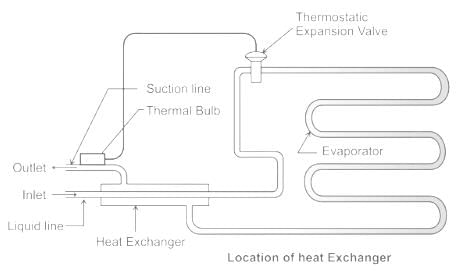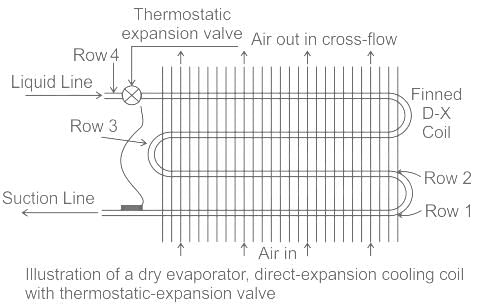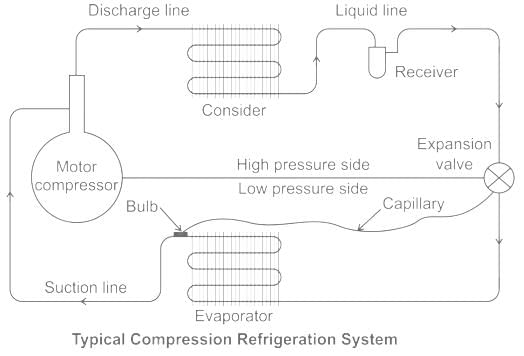All Exams >
Mechanical Engineering >
6 Months Preparation for GATE Mechanical >
All Questions
All questions of Evaporators for Mechanical Engineering Exam
A suction line liquid line heat exchanger cause- a)Subcooling of liquid refrigerant entering the expansion device
- b)Superheating of the suction vapour
- c)May increase or decrease COP
- d)All of the above
Correct answer is option 'D'. Can you explain this answer?
A suction line liquid line heat exchanger cause
a)
Subcooling of liquid refrigerant entering the expansion device
b)
Superheating of the suction vapour
c)
May increase or decrease COP
d)
All of the above
|
|
Rhea Reddy answered |
A liquid line and suction line heat exchanger are used to transfer heat between liquid refrigerant leaving the condenser on the high-pressure side of the system and refrigerant vapour leaving the evaporator on the low-pressure side of the system.
This heat transfer causes following effects
- To raise the vapour temperature (Superheating) to prevent frosting or condensation on the suction line
- To evaporate any remaining liquid in the vapour stream to prevent possible compressor damage
- To sub-cool the liquid to prevent flash gas in the liquid line
- To increase the system refrigerating capacity

Plate type evaporators are employed in- a)Air cooler
- b)Window AC
- c)Refrigerator
- d)Split Air conditioner
Correct answer is option 'C'. Can you explain this answer?
Plate type evaporators are employed in
a)
Air cooler
b)
Window AC
c)
Refrigerator
d)
Split Air conditioner
|
|
Rhea Reddy answered |
Types of Evaporator:
- Bare tube Evaporator: These are constructed of either steel pipe or copper tubing. These are simplest type of evaporators. Steel pipe is used for large evaporators and copper tube is used for smaller evaporators. Common shapes are zig-zag flat or spiral. These are used where temperature is maintained below 0°C.
- Plate Surface Evaporator: These are made up of two flat sheets of metal so embossed and welded together as to provide a path for refrigerant flow between two sheets. It is usually cleaned and defrosted manually. It is used in domestic refrigerators.
- Finned Tube Evaporators: Finned coil are bare tube coil upon which metal plates or fins are installed. The use of fins increases the overall surface area of evaporator.
What is the purpose of chemical spraying on finned evaporators?- a)Flush out the condenser tubes
- b)Remove the rust on the fins
- c)Blow the dust from the fins
- d)Correct the bends in fins
Correct answer is option 'B'. Can you explain this answer?
What is the purpose of chemical spraying on finned evaporators?
a)
Flush out the condenser tubes
b)
Remove the rust on the fins
c)
Blow the dust from the fins
d)
Correct the bends in fins
|
|
Rhea Reddy answered |
Finned evaporator:
- The finned evaporators consist of bare tubes or coils over which the total plates or fins are fastened.
- The metal fins are constructed of thin sheets of metal having good thermal conductivity.
- Since the fins greatly increase the contact surfaces for heat transfer, therefore the finned evaporators are also called extended surface evaporators.
- The finned evaporators are primarily designed for air conditioning applications where the refrigerator temperature is above 0°C.
- Because of the rapid heat transfer of the finned evaporator, it will defrost itself on the off cycle when the temperature of the coil is near 0°C.
- Moisture in the air causes rusty formation on the Aluminium fins and it can be cleared by spraying rust-removing chemicals when the unit is under service.

Which is simplest type of evaporator.- a)Plate
- b)Finned
- c)Bare tube coil
- d)Extended surface
Correct answer is option 'C'. Can you explain this answer?
Which is simplest type of evaporator.
a)
Plate
b)
Finned
c)
Bare tube coil
d)
Extended surface
|
|
Rhea Reddy answered |
Types of Evaporator:
- Bare tube Evaporator: These are constructed of either steel pipe or copper tubing. These are the simplest type of evaporators. Steel pipe is used for large evaporators and the copper tube is used for smaller evaporators. Common shapes are zig-zag flat or spiral. These are used where the temperature is maintained below 0°C.
- Plate Surface Evaporator: These are made up of two flat sheets of metal so embossed and welded together to provide a path for refrigerant flow between two sheets. It is usually cleaned and defrosted manually. It is used in domestic refrigerators.
- Finned Tube Evaporators: Finned coil is bare tube coil upon which metal plates or fins are installed. The use of fins increases the overall surface area of the evaporator.
If the amount of water vapour in the air is high, then the rate of evaporation is ______.- a)Will decrease
- b)Will be zero
- c)Will remain the same
- d)Will Increase
Correct answer is option 'A'. Can you explain this answer?
If the amount of water vapour in the air is high, then the rate of evaporation is ______.
a)
Will decrease
b)
Will be zero
c)
Will remain the same
d)
Will Increase
|
|
Rhea Reddy answered |
The correct answer is Will decrease.
- If the humidity in the atmosphere is high, the rate of evaporation is low because the air is filled with water vapor and is not able to take up more humidity. Thus, the evaporation process slows down.
The refrigerator’s evaporator can also be termed as- a)Cooler
- b)Freezer
- c)Cool creator
- d)Heat Transmitter
Correct answer is option 'B'. Can you explain this answer?
The refrigerator’s evaporator can also be termed as
a)
Cooler
b)
Freezer
c)
Cool creator
d)
Heat Transmitter
|
|
Rhea Reddy answered |
Evaporator is the heat absorbing part of the refrigeration system. This is also called cooling coil, freezer or chiller. These names are according to their function in the system. In the domestic refrigerator it is termed as freezer.
Frost is formed on cooling coils due to ______- a)Moisture present in evaporator
- b)Moisture present in condenser
- c)Moisture present in compressor
- d)None of these
Correct answer is option 'A'. Can you explain this answer?
Frost is formed on cooling coils due to ______
a)
Moisture present in evaporator
b)
Moisture present in condenser
c)
Moisture present in compressor
d)
None of these
|
|
Rhea Reddy answered |
The moisture present in the evaporator section of refrigerator is cooled and converted to the frost. This ice formed affects the heat transfer rate in the evaporator and increase the electricity consumption.
In the evaporator of refrigerator system, the refrigerant changes from ______- a)Vapour to liquid
- b)Liquid to vapour
- c)Remains in liquid form
- d)None of these
Correct answer is option 'B'. Can you explain this answer?
In the evaporator of refrigerator system, the refrigerant changes from ______
a)
Vapour to liquid
b)
Liquid to vapour
c)
Remains in liquid form
d)
None of these
|
|
Rhea Reddy answered |
Refrigeration is a process of heat removal from a substance or from a space resulting in lower temperature below that of the surroundings. Major parts of the conventional refrigeration system are as followed.
Evaporator: It is the part where cooling takes place. The heat is absorbed in the evaporator. The liquid refrigerant is converted into vapour refrigerant in the evaporator.
Condenser: The function of the condenser is to remove the heat carried by the refrigerant and reduce its temperature at constant pressure.
Receiver: It is the reservoir for excess liquid refrigerant not being in the system.


Dry evaporator is one in which?- a)The exit from evaporator is dry saturated refrigerant
- b)The exit from evaporator is superheated refrigerant
- c)The exit from evaporator has refrigerant with high dryness fraction
- d)The inlet to the evaporator has refrigerant with some dryness fraction
Correct answer is option 'B'. Can you explain this answer?
Dry evaporator is one in which?
a)
The exit from evaporator is dry saturated refrigerant
b)
The exit from evaporator is superheated refrigerant
c)
The exit from evaporator has refrigerant with high dryness fraction
d)
The inlet to the evaporator has refrigerant with some dryness fraction
|
|
Rhea Reddy answered |
In the dry evaporator, the liquid refrigerant is generally fed by an expansion valve. The valve controls the rate of flow of refrigerant in such a way that all the liquid is vaporised, and the vapour is also superheated by the time it reaches the evaporator exit.
What is the state of the refrigerant when it enters into the evaporator?- a)High pressure, low temperature
- b)Low pressure, medium temperature
- c)Low pressure, low temperature
- d)Medium pressure, low temperature
Correct answer is option 'C'. Can you explain this answer?
What is the state of the refrigerant when it enters into the evaporator?
a)
High pressure, low temperature
b)
Low pressure, medium temperature
c)
Low pressure, low temperature
d)
Medium pressure, low temperature
|
|
Rhea Reddy answered |
The refrigerant at the entry to the evaporator is low pressure and low temperature liquid. The pressure is reduced in the capillary tube thus also decreasing the temperature. This low pressure, low temperature liquid is converted to low pressure vapours after absorbing heat from the evaporator.
Chapter doubts & questions for Evaporators - 6 Months Preparation for GATE Mechanical 2025 is part of Mechanical Engineering exam preparation. The chapters have been prepared according to the Mechanical Engineering exam syllabus. The Chapter doubts & questions, notes, tests & MCQs are made for Mechanical Engineering 2025 Exam. Find important definitions, questions, notes, meanings, examples, exercises, MCQs and online tests here.
Chapter doubts & questions of Evaporators - 6 Months Preparation for GATE Mechanical in English & Hindi are available as part of Mechanical Engineering exam.
Download more important topics, notes, lectures and mock test series for Mechanical Engineering Exam by signing up for free.
6 Months Preparation for GATE Mechanical
499 videos|1037 docs|710 tests
|

Contact Support
Our team is online on weekdays between 10 AM - 7 PM
Typical reply within 3 hours
|
Free Exam Preparation
at your Fingertips!
Access Free Study Material - Test Series, Structured Courses, Free Videos & Study Notes and Prepare for Your Exam With Ease

 Join the 10M+ students on EduRev
Join the 10M+ students on EduRev
|

|
Create your account for free
OR
Forgot Password
OR
Signup on EduRev and stay on top of your study goals
10M+ students crushing their study goals daily









